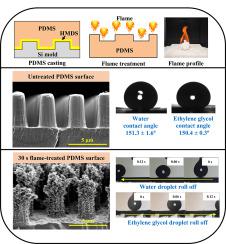当前位置:
X-MOL 学术
›
Microelectron. Eng.
›
论文详情
Our official English website, www.x-mol.net, welcomes your feedback! (Note: you will need to create a separate account there.)
Superhydrophobic and superoleophobic properties enhancement on PDMS micro-structure using simple flame treatment method
Microelectronic Engineering ( IF 2.3 ) Pub Date : 2020-06-01 , DOI: 10.1016/j.mee.2020.111362 Nithi Atthi , Witsaroot Sripumkhai , Pattaraluck Pattamang , Oraphan Thongsook , Rattanawan Meananeatra , Pawasuth Saengdee , Arckom Srihapat , Jakrapong Supadech , Tanawat Janseng , Apidech Maneesong , Natthapol Kongto , Aphichart Rodchanarowan , Nipapan Klunngien , Wutthinan Jeamsaksiri
Microelectronic Engineering ( IF 2.3 ) Pub Date : 2020-06-01 , DOI: 10.1016/j.mee.2020.111362 Nithi Atthi , Witsaroot Sripumkhai , Pattaraluck Pattamang , Oraphan Thongsook , Rattanawan Meananeatra , Pawasuth Saengdee , Arckom Srihapat , Jakrapong Supadech , Tanawat Janseng , Apidech Maneesong , Natthapol Kongto , Aphichart Rodchanarowan , Nipapan Klunngien , Wutthinan Jeamsaksiri

|
Abstract In this research, a simple flame treatment method was explored to generate micro−/nano-structures on polydimethylsiloxane (PDMS) micro-patterns. Ethanol soaked paper wipes were used as a flame source at a temperature of 700 ± 20 °C. After flame-treated for 30 s, a unique flower petal nano-structures were formed on all surface types: flat PDMS (PDMS-FLT) and PDMS with square pillar pattern (PDMS-PIL) and PDMS with rectangular ridge patterns (PDMS-REC). The flower petal nano-structures, which acts like a re-entrant micro−/nano-structure, was formed by an aggregation of organosilicon compounds in PDMS matrix. Averaged values of surface roughness of the PDMS-FLT, the PDMS-REC and the PDMS-PIL have increased to 298.9, 662.3, and 731.1 nm, respectively. The PDMS-PIL surface that was flame-treated for 30 s exhibited superhydrophobic and superoleophobic properties with water and ethylene glycol contact angle greater than 150°. Those properties led to liquid droplets spreading out instantly and rolling off very fast. Therefore, the flame treatment is expected to be one promising method to fabricate biomimetic surface with good reproducibility and stability on a large-scale antifouling surface for various applications.
中文翻译:

使用简单的火焰处理方法增强PDMS微结构的超疏水和超疏油性能
摘要 在这项研究中,探索了一种简单的火焰处理方法在聚二甲基硅氧烷 (PDMS) 微图案上生成微/纳米结构。乙醇浸湿的纸巾在 700 ± 20 °C 的温度下用作火焰源。火焰处理 30 秒后,在所有表面类型上形成了独特的花瓣纳米结构:平面 PDMS (PDMS-FLT) 和方柱图案的 PDMS (PDMS-PIL) 和矩形脊图案的 PDMS (PDMS-REC) )。花瓣纳米结构就像一个可折返的微/纳米结构,是由有机硅化合物在 PDMS 基质中的聚集形成的。PDMS-FLT、PDMS-REC 和 PDMS-PIL 的表面粗糙度平均值分别增加到 298.9、662.3 和 731.1 nm。经火焰处理30 s的PDMS-PIL表面表现出超疏水和超疏油特性,水和乙二醇的接触角大于150°。这些特性导致液滴立即扩散并快速滚落。因此,火焰处理有望成为一种在大规模防污表面上制备具有良好重现性和稳定性的仿生表面的有前途的方法,用于各种应用。
更新日期:2020-06-01
中文翻译:

使用简单的火焰处理方法增强PDMS微结构的超疏水和超疏油性能
摘要 在这项研究中,探索了一种简单的火焰处理方法在聚二甲基硅氧烷 (PDMS) 微图案上生成微/纳米结构。乙醇浸湿的纸巾在 700 ± 20 °C 的温度下用作火焰源。火焰处理 30 秒后,在所有表面类型上形成了独特的花瓣纳米结构:平面 PDMS (PDMS-FLT) 和方柱图案的 PDMS (PDMS-PIL) 和矩形脊图案的 PDMS (PDMS-REC) )。花瓣纳米结构就像一个可折返的微/纳米结构,是由有机硅化合物在 PDMS 基质中的聚集形成的。PDMS-FLT、PDMS-REC 和 PDMS-PIL 的表面粗糙度平均值分别增加到 298.9、662.3 和 731.1 nm。经火焰处理30 s的PDMS-PIL表面表现出超疏水和超疏油特性,水和乙二醇的接触角大于150°。这些特性导致液滴立即扩散并快速滚落。因此,火焰处理有望成为一种在大规模防污表面上制备具有良好重现性和稳定性的仿生表面的有前途的方法,用于各种应用。


























 京公网安备 11010802027423号
京公网安备 11010802027423号